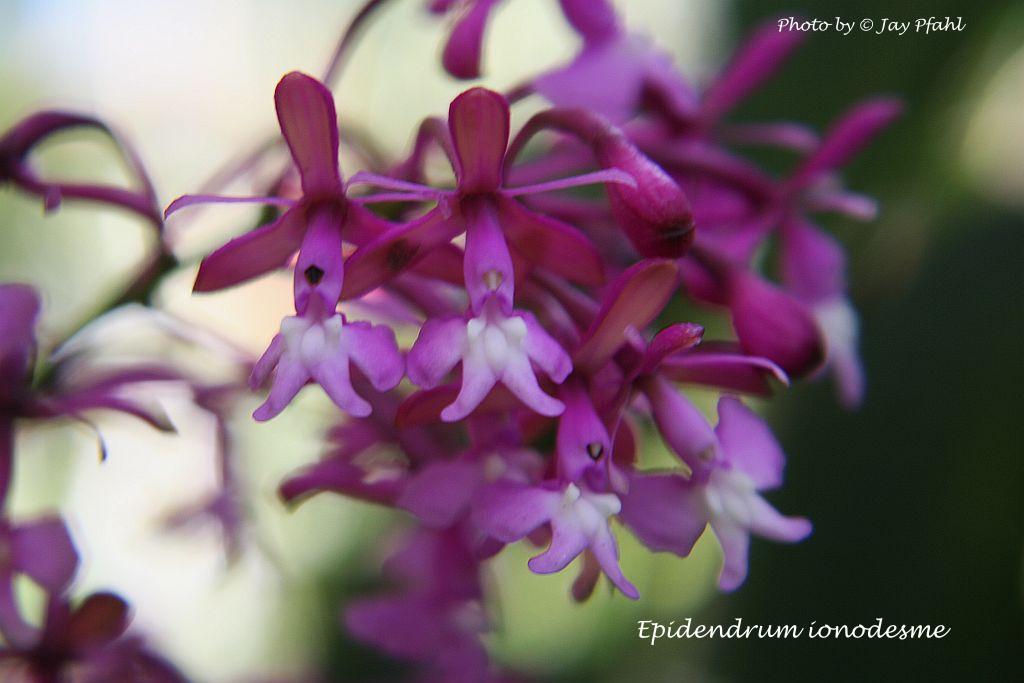

Epidendrum laeve Lindley 1844 GROUP Pseudepidendrum SUBGROUP Paniculatum
Photos by © Jay Pfahl

 to
to 


Common Name The Smooth Epidendrum
Flower Size 1" [2.5 cm]
Found in Antioquia, Quindio, Valle De Cauca and Narino departments of Colombia at elevations of 1800 to 2200 meters as a large to giant sized, cool to cold growing epiphyte or terrestrial with erect, simple, canelike, terete, straight stems enveloped basally by tubular, non-foliaceous, scarious sheaths and carrying 13 distributed all along the apical 1/2 of the stem, alternate, articulate, subcoriaceous, oblong-lanceolate, acute, margin entire leaves that blooms in the fall and winter on a terminal, erect, paniculate; peduncle, laterally compressed thin, enveloped by 2 to 4, tubular, acute, partially imbricating sheaths, straight, 3.2 to 6" [8 to 15 cm] long; rachis terete, with 3 to 10, short, somewhat spreading, densely many flowered branches each subtended by a narrowly triangular, acuminate bract; simultaneously 50 to 180 flowered inflorescence with much shorter than the ovary, narrowly triangular, acuminate, amplexicaul floral bracts.
This species is most often refered to as E ionodesme Schlechter 1920, especially in Colombia where it occurs with the similar E hypoporphyreum with purple undersides to the leaves and E porphyreum with the leaves somewhat wider .6 to 1.6" [1.5 to 4 cm], green and concolor; the lateral lobes of the lip are ovate-dolabriform, and the mid-lobe widely deltoid, divided into a pair of triangular lobes.
"Epidendrum leave Lindl. (syn.: Epidendrum ionodesme Schltr., Santiago & Hágsater 2010a) belongs to the 1844 GROUP Pseudepidendrum which is characterized by caespitose plants, cane-like stems, acute to acuminate leaves, usually apical inflorescence, the mostly filiform petals and the lip usually 3-lobed with 3 parallel fleshy keels, the apical lobe often bifurcate, the “bird-wing” type pollinia, at least the inner pair, and 1844 SUBGROUP Paniculatum which has flowers colored reddish orange, deep purple or lilac-pink, the calli generally prominent, sometimes horn-like. The species has the lateral lobes of the lip dolabriform-trapezoid, the width of the lip equal in width between the lateral lobes and the mid-lobe, the mid-lobe is deeply emarginate at the apex and forms a pair of linear-oblong, divergent lobes, the column is short, .32 to .36" [8 to 9 mm] long. Epidendrum hypoporphyerum is recognized by the oblong-elliptic leaves, ventrally tinged with purple; the purple-rose flowers with the disc of the lip cream-colored, sepals .44 to .64" [11 to 16 mm]long; the lateral lobes of the lip are trapezoid, somewhat falcate, the basal margin somewhat involute, the mid-lobe widely triangular, widely emarginate, margin entire, spreading, forming a pair of oblong, divergent lobes, the apices rounded. It is similar to Epidendrum porphyreum Lindley which has similar plants, but the leaves are somewhat wider .6 to 1.6" [1.5 to 4 cm], green and concolor; the lateral lobes of the lip are ovate-dolabriform, and the mid-lobe widely deltoid, divided into a pair of triangular lobes." Adapted from Plate 1441 Hagsater etal 2013
Synonyms Epidendrum ionodesme Schlechter 1920
References W3 Tropicos, Kew Monocot list , IPNI ; *Repert. Spec. Nov. Regni Veg. Beih. 7: 134 Schlechter 1920 as E ionodesme; Repert. Spec. Nov. Regni Veg. Beih. 7: 247 Schlechter 1920 as E ionodesme; Repert. Spec. Nov. Regni Veg. Beih. Figuren-Atlas 57: 182 Schlechter 1929 as E ionodesme drawing fide; Bot Notiser 130 Lojtnant 1977 as E ionodesme; Native Colombian Orchids Vol 2 COS 1991 as E ionodesme photo fide; Icones Orchidacearum 3 Plate 307 Hagsater 1999 as E ionodesme see recognition section; Orquideas Nativas del Tachira Cesar Fernandez 2003 as E ionodesme photo fide; AOS Bulletin Vol 74 No 5 2005 as E ionodesme photo fide; Orquideologia Vol 24 #1 2005 photo fide; Icones Orchidacearum 13 Plate 1320 Hagsater 2010 as E ionodesme see recognition section; Icones Orchidacearum 13 Plate 1344 Hagsater 2010 see recognition section drawing fide; Icones Orchidacearum 13 Plate 1369 Hagsater & Dodson 2010 See Recognition section; Icones Orchidacearum 13 Plate 1377 Hagsater & Dodson 2010 See Recognition section; Icones Orchidacearum 14 Plate 1441 Hagsater & Santiago 2013 See recognition section; Orquideologia Vol 29 #1 2012 photo fide; Orquideologia 29: 1 2012 as E ionodesme photo fide; Orchids of the Department of Valle De Cauca Colombia Vol 2 Kolanowska, Hagsater etal. 2014 drawing/photo fide; Icones Orchidacearum 18(2) Plate 1856 Hagsater & Jimenez 2021 see recognition section; Icones Orchidacearum 18(2) Plate 1857 Hagsater & Jimenez 2021 see recognition section
--------------------------------------------------------------------------------------------------------------------------